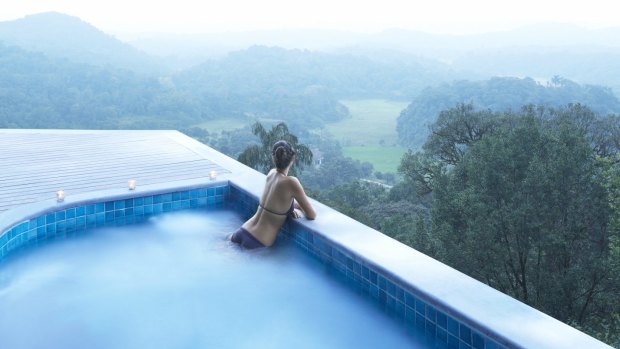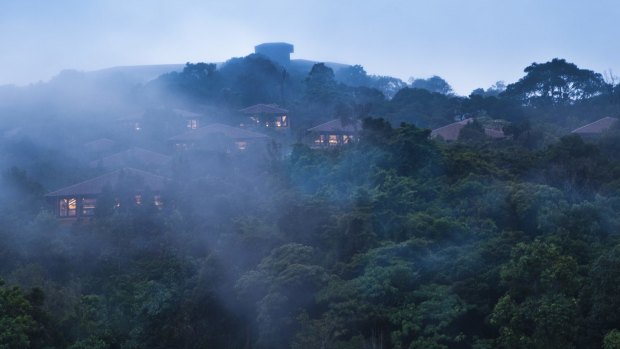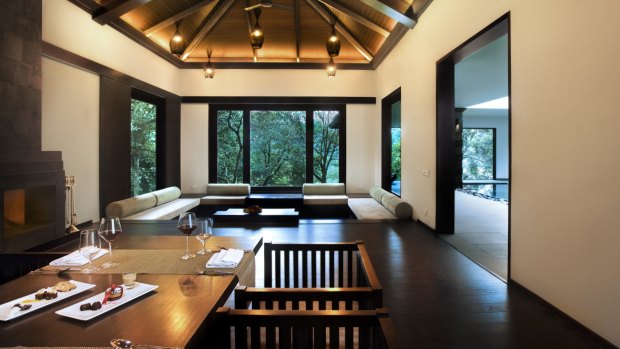This was published 4 years ago
Western Ghats, Coorg, Western Ghats, India: Villas and ayurvedic spa in a World Heritage bio-diverse hotspot
By Andrea Black

The luxury Taj Madikeri Resort and Spa.
After the monsoonal rains comes the music. There's an awkward shrill followed by human-like melodious whistling floating through the air across the forest canopy in Coorg, part of the Western Ghats mountain range in southern India.
"Sounds like a whistling schoolboy, doesn't it?" Retired Colonel Muthanna says as he guides us around the Taj Conservatory, part of Taj Madikeri Resort and Spa. He's dressed in brown corduroy, suspenders and a smart wool hat. A cord vest hangs over his office chair, where he's been seated, writing his memoirs by hand. The colonel is describing the morning call of the Malabar whistling thrush, the blue-hued signature bird of the resort. "We call them schoolboys because they sound like a person learning how to whistle," he explains.
The thrush is just one of the 300 types of birds, together with 200 species of plants at this UNESCO World Heritage Site. The colonel shares his expertise on the history, culture and nature of Coorg while pointing out artefacts, photographs and artworks in the conservatory.

They call this the Scotland of India, with mists rolling into the verdant high-altitude valleys.
These rainswept forests and mountain ranges provide an ecosystem in which many species of birds, animals and plants thrive. The Western Ghats is recognised as one of the world's eight "hottest hotspots" of biological diversity. The luxury Taj Madikeri Resort and Spa, a sanctuary on 72 hectares and perched 1200 metres above sea level, sits among these ranges, seemingly a world away from the colour, crowds and chaos of India's big cities. They call it the Scotland of India, with mists rolling into the verdant high-altitude valleys. The resort attracts Indian and international visitors looking for luxury adventure, and some respite.
Come afternoon, the mist clears and we leave for a nature walk with one of the resort's naturalists, nicknamed the "Rainforest Insider". We wander among hills peppered with rudraksha trees, cardamom, coffee, jasmine and Malabar tamarind, a pumpkin-like fruit used in Coorg cuisine. And figs. Lots of figs. Taj has planted more than 45,000 fruiting trees in the last couple of years to help bring the vegetation back to what is was before coffee and lantana changed the topography. We walk by the resort's organic garden full of ripe strawberries, mulberries, avocados (so many the resident pigs feast on them, too) and gooseberries. The resort also has an apiary for bees.
We're shown a sacred grove, known as Devarakadu, believed to be an abode of the gods. Here there are strict laws and taboos against poaching and the felling of trees. These groves are also an important storehouse of biodiversity. Wildlife roams freely. Egrets follow cattle and wild cats paw through the greenery. There are 370 types of snakes. A lucky few may spy a slender loris or perhaps the nilgiri marten. Tigers have been spotted, and elephants are a common sight. Our Rainforest Insider keeps a close watch. The other day, he tells us, an elephant stood by the same banana tree we seek shade beneath.

The luxury Taj Madikeri Resort and Spa seems a world away from the colour, crowds and chaos of India's big cities.
After the hike comes the foot soak. In my villa, one of 63 spread out on a hillside, a warm rose-petal topped footbath awaits, placed in front of the floor-to-ceiling window. Beyond that window is a panoramic view of the valley. I sit back with the room copy of Flights of Fancy compiled for the resort by ornithologist Dr S. V. Narasimhan and do some more spotting. The villas feature hardwood floors, a fireplace and bay windows. The compressed bricks, used to build each villa, are made onsite with displaced soil, and all roof tiles are recycled and handmade.
Natural river stones are used throughout the property including the stepping stone entry to the resort's Jiva spa. After a dip in the temperature-controlled infinity pool one might want to try the gudda bath experience, a scrub and massage performed sitting up and using a copper pot (gudda) to pour the warm water, or maybe an ayurvedic consultation with resident expert, Dr Raj. I opt for an avocado body polish, a signature blend sourced from the resort grounds. Avocado nourishes, coffee stimulates and rice powder cleanses.
Night falls, and a golf buggy transports me back to my villa. A fog rolls in. The music starts again, this time the sounds come from batracharium, the resort's sanctuary for frogs where, so far, 41 types of amphibians have been identified. Their calls form a syncopated beat before those whistling schoolboys chime in again.
TRIP NOTES
MORE
india.com/travel/western-ghats
TOUR
Adventure World Travel tailors South India experiences, from flights to ground transport, tour guides, local specialists, accommodation and activities. See adventureworld.com.au; tajhotels.com
Andrea Black was a guest of Adventure World Travel and Taj Hotels.
Sign up for the Traveller Deals newsletter
Get exclusive travel deals delivered straight to your inbox. Sign up now.